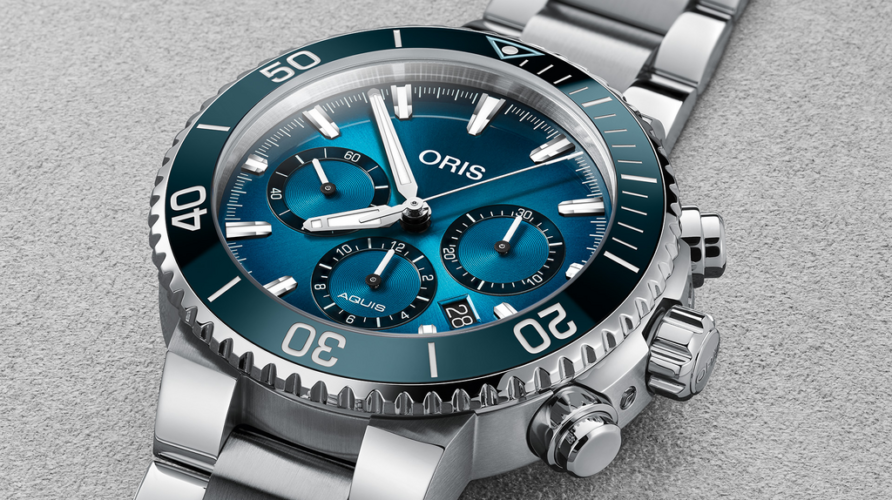The watch has become a staple accessory in fashion for hundreds of years; the first mechanical pocket watches date back to the early 16th century, with ensuing evolutionary designs over the next five hundred years would turn the watch from curiosity into a fashion mainstay. Some of the finest watches emanate from Switzerland, home to famed luxury brands such as Breitling, Omega, Raymond Weil and Rolex. These groups represent a sacred fraternity within the Swiss economy, the Manufacture d’horlogerie, and convey a symbol of excellence and prestige within the community of mechanical watchmakers.
One of the most interesting companies to come out of this community of class is based out of Hölstein in the canton of Basel-Landschaft. Since 1904, Oris SA has been producing mechanical watches out of their home base, levying their penchant for quality and precision to establish one of the preeminent brands out of Switzerland. As with many Swiss manufacturers, their story is one filled with ups and downs as the company navigated rough headwaters in a tumultuous 20th century to not only survive as a company but thrive as a brand of quality and luxury. Join us as we explore at the story of Oris and their colorful history.
The Foundation of the Brand
Oris traces its roots to the closure of another watchmaker in Hölstein, Lohner & Co. Two entrepreneurs, Paul Cattin and Georges Christian purchased the remains of the factory and entered into contract with the town to begin producing watches in June 1904. In its first year of operation, the company employed over sixty employees producing pocket watches; their enterprise would rapidly expand within the first twenty-four months to a brand new production factory in the nearby village of Holderbank. Within its first five years of existence, Oris became the largest single employer in Hölstein; to help complement the workforce, the company began building houses and apartments for its employees.
By 1925, Oris maintained six separate factories in Hölstein, Holderbank, Como, Courgenay, Herbetswil and Ziefen. It was in 1925 in their Ziefen factory that the company begins an experiment, fitting bracelet buckles to their pocket watches, creating the brand’s first fully-fledged wristwatches. This initial era of growth and expansion meets its first challenge in 1927 however with the passing of company co-founder Georges Christian. Jacques-David LeCoultre, grandson of famed watchmaker Antoine LeCoultre and future co-owner of Jaeger-LeCoultre steps in to become the new President of the Board of Directors. Christian’s brother-in-law Oscar Herzog takes over as the General Manager, a position he would hold for 43 years until 1971.
Legal Battles and the Challenges of War
In March 1934, the Swiss government passed the ‘Watch Statute’, a law which was constructed to – in principle – protect the Swiss watchmaking industry by requiring all changes to watch technologies be cleared by the government before receiving implementation. For Oris, a company that cut against the grain by using Roskopf (pin-lever) escapement movements in their watches compared to the lever escapement movements favored by their competition, this posed a major challenge. The company would continually campaign against the Watch Statute for years, going so far as to hire a young lawyer named Dr. Rolf Portmann (more on him later) in 1956 to represent the company in challenging the statute. Though the law would be relaxed over the years, its full repeal would not be implemented until 1971.
The 1930s would see a period of unique progression for the company: one of its signature watch lines, the ‘Big Crown’ model pilot’s watch would be introduced in 1938, establishing aviation as one of the four major “worlds” or areas of focus that Oris would come to focus its energy on over time. The ‘30s would also see the company integrate its workforce by offering women employment along with men, something of a rarity in the country at that time. However, the advent of World War II (1939-1945) would severely curtail the company’s distribution networks beyond Switzerland, forcing innovative solutions to remain competitive; one such innovation was the development of alarm clocks, including an eight-day power reserve model in 1949 that helps Oris win the first of over 200 awards for accuracy from the Bureau Officiel de Contrôle de la Marche des Montres.
The Quartz Crisis
By the end of the 1960s, Oris was one of the ten largest watchmakers in Switzerland, employing over 800 people in multiple factories around the country. The liberalization of the Watch Statute and the introduction in 1965 of their signature diver’s watch marked a high point for the company. An apprenticeship program was helping train forty engineers and watchmakers a year by 1970, with over a million wristwatches and clocks being produced in their factories. But the watch industry was evolving at an ever-faster pace: new quartz clocks and watches, using crystal oscillators in their manufacture to help keep more accurate time were beginning to sweep away mechanical watches at an alarming rate. In a bid to retain its market share, Oris agrees to become part of Allgemeine Schweizer Uhrenindustrie AG, or ASUAG – the predecessor to the Swatch Group.
Fortunes continued to wane during the 1970s as the Quartz Crisis deepened; over 900 companies were shuttered in Switzerland in this period, and over two-thirds of watchmakers were forced out of work. Oris did unveil its popular Chronoris model in 1970 to some fanfare, but the company’s losses reflected in it shrinking size. From a maximum of over 800 employees in the 1960s, only a few dozen remained with the company by 1980. By 1981, the company which had long prided itself on producing many of its own internal components needed for watchmaking stopped making its own movements. Recognizing that Oris’s future could not compete within the quartz clock market, a buyout was organized by Dr. Rolf Portmann – the same man that had fought to overturn the Watch Statute for the company – and marketing chair Ulrich W. Herzog. This move would return Oris to independence and would also return it to the mechanical marketplace.



